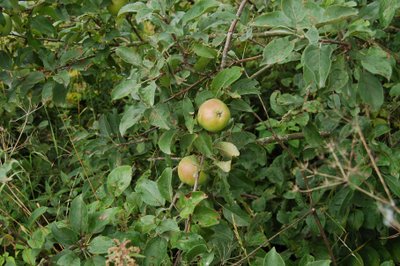 ¨
¨The ancient Egyptians planted apple trees by the Nile, the ancient Greeks cultivated apples - and the Etruscians and Romans cultivated apples. Wild apples have grown in Denmark since the beginning of time, but the cultivating of apples started not until the Middle Ages. The monasteries were significant for the spreading of apples in Europe. The earliest identification origins from a monastery in England in the year 1204.
The autumn is a treasure chest of wild raw materials . There are lots to be found- mushrooms, hazelnuts or wild apples, sloe, rowanberry, juniper berry, blackberry, cowberry, elderberry - probably a rich season this year.
The wild apples are sour and best mixed with cultivated apples in jelly, marmelade, stewed fruit apple wine and so on.
But if you have gathered some wild apples, then they are also fine in a Russian Apple Pie. (Sharlotka) First use dark, dry bread crums, and fry them in butter . Remove from heat and add red wine , lemon juice, sugar (a little more than usual) and orange peel. Mix well. Add vanilla sugar. Butter a tin well and sprinkle it lightly with dark bread crumbs . Put a layer of the bread crumb mix at the bottom of the tin, then a layer of thin apple slices and cinnamon. Eventually more layers. Finish with the bread crumb mix. Put the tin in the oven for moderate or low heat = 150 degrees and let it bake for a little hour. Serve it hot - eventually with whipped cream.
photo Hærvejen Mid Jutland: grethe bachmann
No comments:
Post a Comment